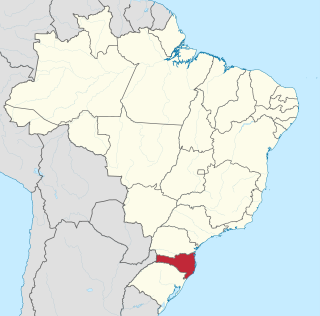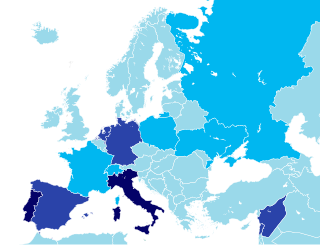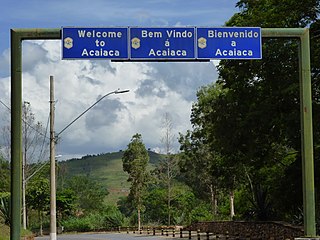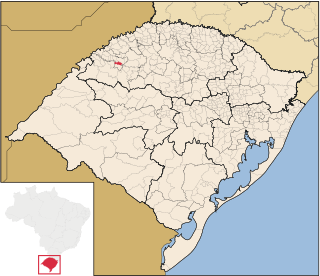Related Research Articles

Santa Catarina is one of the 27 federative units of Brazil. It is located in the centre of the country's Southern region. It is bordered to the north by the state of Paraná, to the south by the state of Rio Grande do Sul, to the east by the Atlantic Ocean, and to the west by the Argentine province of Misiones.
Hunsrik, also called Riograndese Hunsrik, Riograndenser Hunsrückisch or Katharinensisch, is a Moselle Franconian language derived primarily from the Hunsrückisch dialect of West Central German which is spoken in parts of South America. A co-official language in the Brazilian municipalities of Antônio Carlos, Santa Maria do Herval, and São João do Oeste, Hunsrik is spoken in the states of Rio Grande do Sul, Santa Catarina, and Paraná, as well as some regions of neighboring Paraguay and Argentina. It has been an integral part of the historical and cultural heritage of the Brazilian state of Rio Grande do Sul since 2012, and considered an intangible cultural heritage of Santa Catarina state since 2016.
Talian, or Brazilian Venetian, or Vêneto is a Venetian dialect spoken primarily in the Serra Gaúcha region in the northeast of the state of Rio Grande do Sul in Brazil. It is also spoken in other parts of Rio Grande do Sul, as well as in parts of Espírito Santo and of Santa Catarina.

São Leopoldo is a Brazilian industrial city located in the south state of Rio Grande do Sul.
The German-based varieties spoken by German Brazilians together form a significant minority language in Brazil. "Brazilian German" is strongly influenced by Portuguese and to a lesser extent by Italian dialects as well as indigenous languages. High German and Low Saxon/German dialects and Germanic languages are particularly strong in Brazil's South and Southeast Regions. According to Ethnologue, ca. 3 million people in Brazil speak the Hunsrik Language, 1.5 million speak Standard German.

Immigration to Brazil is the movement to Brazil of foreign peoples to reside permanently. It should not be confused with the forcible bringing of people from Africa as slaves. Latin Europe accounted for four-fifths of the arrivals. This engendered a strikingly multicultural society. Yet over a few generations, Brazil absorbed these new populations in a manner that resembles the experience of the rest of the New World.
East Pomeranian or Farther Pomeranian is an East Low German dialect moribund in Europe, which used to be spoken in the region of Farther Pomerania when it was part of the German Province of Pomerania, until World War II, and today is part of Poland. Currently, the language survives mainly in Brazil, where it is spoken by descendants of German immigrants of the 19th century and where it was given its own script by the linguist Ismael Tressmann. It has co-official status in 11 Brazilian municipalities and has been recognized as a historical and cultural heritage of the Brazilian state of Espírito Santo. East Pomeranian is also spoken in central Wisconsin and parts of Iowa, in the United States.

Santo Ângelo is a municipality located in northwestern Rio Grande do Sul state, Brazil. It has about 77,568 inhabitants and the total area of the municipality is about 679 km2. It borders Giruá to the north, and Entre-Ijuís to the south—it's linked to Santo Ângelo by the state road RS 344. The city is located 443 km (275 mi) from the state capital, Porto Alegre.

Portuguese is the official and national language of Brazil being widely spoken by most of the population. Brazil is the most populous Portuguese-speaking country in the world, with its lands comprising the majority of Portugal's former colonial holdings in the Americas.
Missões, Brazil is a region of Rio Grande do Sul in Brazil roughly occupying the same area previously dominated by the colonial missions founded by Saint Roque González.

Mato Queimado is a Brazilian municipality located in the northwestern part of the state of the Rio Grande do Sul. The population is about 1,629 in an area of 114.64 km². It is located 489 km in the west of the state capital of Porto Alegre and northeast of Alegrete.

The languages of South America can be divided into three broad groups:
Esmeralda is a municipality in the state of Rio Grande do Sul, Brazil. It was raised to municipality status in 1963, the area being taken out of the municipality of Vacaria. As of 2020, the estimated population was 3,287.

Flores da Cunha is a municipality in the state of Rio Grande do Sul, Brazil. It is the largest producer of wines inside Brazil. The Venetian language in its Brazilian form Talian is co-official with Portuguese in Flores da Cunha.

Não-Me-Toque is a Brazilian municipality located in the state of Rio Grande do Sul.

Picada Café or Kaffeeschneiss in the local German dialect is a municipality in the state of Rio Grande do Sul, Brazil. It is located around 80 kilometers from the state capital of Porto Alegre.

Sede Nova is a municipality in the state of Rio Grande do Sul, Brazil. As of 2020, the estimated population was 2,891. On July 12 2023 A tornado struck The town with F2 damage.
The following is a timeline of the history of the city of Porto Alegre, in the state of Rio Grande do Sul, Brazil.

The House of Ulhôa Cintra, also known as the House of Minister is a historic residence in Caçapava do Sul, Rio Grande do Sul, Brazil. It was built in the middle of the 19th century and was a meeting place of figures associated with the Ragamuffin War; it notably housed the printing press of their newspaper, O Povo. It was subsequently owned by José Pinheiro de Ulhôa Cintra and his family. The house is in a simple Portuguese colonial style, and covers 435 square metres (4,680 sq ft). Casa de Ulhôa Cintra was listed as a historic structure by the Historic and Artistic Heritage Institute of Rio Grande do Sul in 1994.
References
- ↑ IBGE 2020
- ↑ LEI 14.061 - DECLARA INTEGRANTE DO PATRIMÔNIO HISTÓRICO E CULTURAL DO ESTADO DO RIO GRANDE DO SUL A “LÍNGUA HUNSRIK”, DE ORIGEM GERMÂNICA
- ↑ LEI Nº 14.061, de 23 de julho de 2012 - Declara integrante do patrimônio histórico e cultural do estado do Rio Grande do Sul a língua hunsrik, de origem germânica

